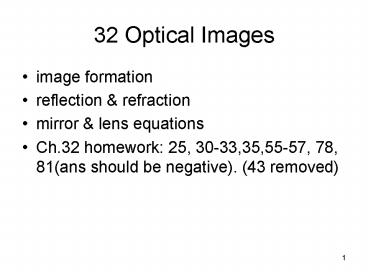32 Optical Images - PowerPoint PPT Presentation
1 / 29
Title:
32 Optical Images
Description:
real image: rays converge to a point. magnifier used to start paper on fire. movie projector. virtual image: rays diverge from source 'seeing' any real object or ... – PowerPoint PPT presentation
Number of Views:14
Avg rating:3.0/5.0
Title: 32 Optical Images
1
32 Optical Images
- image formation
- reflection refraction
- mirror lens equations
- Ch.32 homework 25, 30-33,35,55-57, 78, 81(ans
should be negative). (43 removed)
2
image formation
- real image rays converge to a pointmagnifier
used to start paper on firemovie projector - virtual image rays diverge from sourceseeing
any real object or light source
3
Plane Mirror Image
- distances measured from mirror axis
- image height y object height y
- object distance s image distance s
4
Concave Mirror Image
- distances measured from axis from plane tangent
to mirror at V - focal distance is half of curvature radius
5
principal rays
- 1) parallel ray 2) focal ray 3) radial ray
- image is real, inverted, and smaller in this
situation
1
2
3
6
convex mirror
- parallel and radial rays shown
- image is upright, virtual, and smaller
7
Mirror Equations
you must learn the sign conventions to use these
formulas
8
imbedded object
- image distance lt object distance
9
thin lenses
- have equidistant focal points on either side
- converging diverging types
10
lens equations
11
human eye
- average index of refraction 1.4
12
Far Sighted Eye
- correction requires converging lens
13
near sighted eye
- correction requires diverging lens
14
(No Transcript)
15
(No Transcript)
16
summary
- sections 1 2
- human eye refractive corrections
- (omitting sections 3, 4)
17
Calculating Focal Length for a Thin Lens
Example A double convex, thin glass lens with n
1.5 has radii of curvature of 10 and 15cm. Find
its focal length.
18
O
I
19
Question Reverse the designations in the example
above. Object is now the fish, so n1 1.33 (fish
location). Let the fish be 10cm from bowl
surface. Where is the image of the fish formed
that the cat will see?
Answer s 10cm , s ?, r -15cm, n1 1.33,
n2 1.00.
? 0.133 1/s 0.022 ? 1/s -0.111 ? s
-9.00cm
20
2. A document is sealed in a glass cube (n1.5)
at a depth of 10cm from one surface. Calculate s
and m.
Object is in n11.5. Viewer is in air n21.00.
Radius of surface is r infinity.
? 1/s -0.15 ? s -6.67cm.
.
21
32-3Aberrations
22
(No Transcript)
23
32-4Optical Instruments
24
(No Transcript)
25
(No Transcript)
26
s, cats nose
n1 holds object, here equal to 1.00
0.1 1.33/s 0.022
1.33/s -0.078
s -17.1cm
27
(No Transcript)
28
(No Transcript)
29
(No Transcript)































